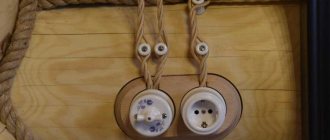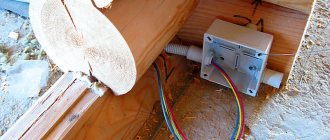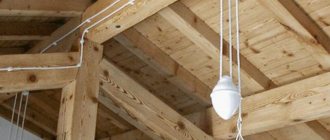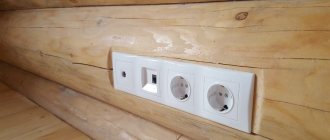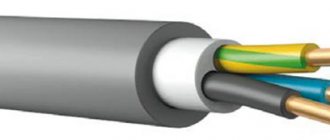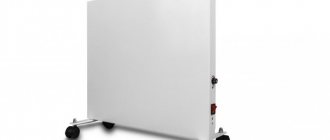The desire of residents of large cities to escape the pollution of megacities and live quietly in their cottages in nature is causing rapid construction of private houses. People most often choose environmentally friendly designs from:
- plain or rounded logs;
- glued or regular timber;
- frame blocks.
The construction of such buildings requires taking into account the performance properties of wood and products made from it.
Design features of wooden houses that influence the choice of heating systems
When choosing a heating scheme for a wooden house, you should consider:
- number of storeys;
- volume of premises;
- shrinkage ability of the building;
- floor construction made of boards on joists.
The number of floors and the capacity of the heated space influence the choice of heating system based on performance, which should create comfortable living conditions even in cold weather.
The fibrous structure of wood contains air, which prevents heat transfer and serves as a good natural heat insulator. However, over time, the relative humidity of even prepared dried wood decreases. The drying process is especially noticeable after the first year of operation of the building, in which the proportions are slightly reduced, and cracks form at the tightly fitted joints of the boards.
Changing the geometry of the walls can not only deform vertical pipelines, but also break their tightness.
In order to prevent such breakdowns, heating is installed a year after the wooden frame is assembled or expansion loops and other devices are used at pipe joints.
When designing electric heating in a wooden house, one should take into account the shrinkage, shrinkage and fire hazard of wood, not forgetting the general thermal insulation.
In this case you can use:
- water/liquid electric boiler, powered by electricity and controlled by an automation system;
- warm floor;
- direct electric heating: radiators and convectors;
- infrared radiation;
- baseboard heating;
- scheme of forced or natural circulation of warm air.
The safest heaters
Heating appliances can be divided into several types, depending on the fuel on which they operate:
- Gas - operate on natural gas or propane. They can be convector and infrared.
- Electric – heat guns and fans, infrared heaters, convectors. Heat is supplied to the room by convection or by emitting infrared waves, which heat surrounding objects, depending on the type of device.
- Solid fuel and liquid fuel - the fuel is coal, peat, firewood, etc. The operating principle of which is based on the combustion of fuel inside the heater and the generation of heat in this process.
Electric heaters are the safest for a wooden house, since they are equipped with overheating protection and other systems.
The main disadvantage of gas heaters is installation problems; heaters can only be used in areas where gas is installed. Additionally, installation permission is required, since gas heaters are dangerous. There is a high probability of gas leakage during operation. Heating devices operating on solid or liquid fuels are also very effectively used to maintain heat in the house. Their main advantage is the speed with which they perform their main task. Within a few minutes the house becomes much warmer, even if the thermometer outside the window shows a significant minus. Fuel heaters have a fairly high efficiency and can operate on one load of fuel for a long time. But at the same time, these types of heaters are not very convenient to use. You need to monitor the level of fuel, purchase it, they form combustion products, require frequent cleaning and constant care, a place to store fuel, emit an odor and make noise during operation. In addition, such devices are quite expensive, and their operation also requires significant expenses. In addition, they are not so safe and can cause a fire or burn.
Due to these features, electric heaters have become widespread. You do not need to obtain special permits to install them, and they are much safer.
Electric boiler
The most effective industrial designs and home-made devices made by folk craftsmen allow you to choose a liquid heating scheme for a wooden house, taking into account climatic and financial capabilities.
When using a system for transferring heat to rooms using radiators, you should consider the piping layout. It can be two-pipe or single-pipe. Each of them has its own advantages. They should be carefully analyzed at the design stage.
Industrial designs of electric boilers use a built-in automation circuit set up in the factory. If you manufacture an electric boiler yourself, you will have to manually regulate its operation or install an additional control and temperature monitoring system.
The automation algorithm will need to take into account the operation of the temperature controller, the safety unit - a safety valve with a pressure gauge, a minimum temperature sensor, a check valve, pressure and anti-condensation pumps, and a water replenishment circuit in the system.
Electricity from alternative sources can be used to heat water from heating elements. A simple homemade wind generator connected without a controller directly to thermal electric heating elements can effectively heat water.
The only condition is that you will have to provide a circuit for putting it into operation: in a cold state, the nichrome wire of the heater has a low ohmic resistance, which will bypass the output circuits of the wind generator. Before connecting it, you will need to heat the nichrome with currents from a stationary network. The resistance of the heating elements will increase and allow the generator to operate.
The energy of a solar battery can be used in the same way, although the integrated inclusion of a wind generator in an electric home solar station is considered the most promising option.
Replacing the battery
The device is equipped with a lithium battery ER14250 or CR2032. Possible replacement options are given in the user manual.
To replace you will need:
- Remove the terminal compartment cover secured with screws on the front side.
- Dismantle the electronic unit in the same way.
- Remove the used element by soldering a new one.
- Reassemble the device in reverse order.
After completing the work, the organization that changed the battery indicates this fact in the corresponding section of the meter passport.
Date: September 25, 2022
Warm floor
The underfloor heating system is based on the use of thermal energy obtained from:
- coolant fluids circulating along lines located under the surface of the floor covering;
- heated electrical cable embedded in the floor.
Electric heated floor.
When using electric heating in a wooden house for such a system, you will have to take care of creating a solid, strong and durable foundation for it. Floor boards can rot over time even after impregnation with special antiseptics. Therefore, it is better to install heating elements on concrete bases using foil heat-insulating coatings, which allow you to return up to 30% of the heat directed down the floor.
The water system requires complex installation by trained specialists and the constant use of only high quality water. Scale and salt deposits inside pipes are unacceptable: the resulting blockages will require expensive repairs, comparable in cost to installing new equipment.
Installation work on an electric heating cable also requires strict implementation of technology and the use of precise measurements, but they are not so complicated and can be performed by a home craftsman.
A warm electric floor can:
- serve as the main heating system of a wooden house;
- complement the existing one to ensure comfort.
In the first case, for each room it will be necessary to use ≥70% of the total area to place heating elements with a consumption capacity of 0.13÷0.17 kW/m2.
Reducing the power to 0.11÷0.13 kW/m2 provides coziness and convenience, but does not completely solve the problem of heating in cold weather.
Both schemes allow:
- adjust the temperature in the room manually or automatically;
- reduce the cost of using electricity using automation;
- operate the system for more than 50 years without repairs.
Types of thermal media
To transfer heat from the generator to the heated room, water is most often used, which has been heated to a certain temperature and circulates through a pipeline.
Today this is the most affordable and simple solution. By correctly calculating the number of radiators and the power of the boiler, you can organize a high-performance system that does not require any special care.
In addition to water heating, in a private wooden house the following is used:
- air;
- oven;
- electric.
A combination option is also often used. A well-designed scheme makes it possible, without spending a lot of money, to build a system that will completely warm up the house in a matter of hours.
If water is used as a heat transfer agent, it must first be filtered. This will significantly increase the service life of heating equipment
Direct electric heating
Oil radiators
The housings of these devices consist of several sections with mineral oil as a coolant, which is heated by powerful heating elements up to 200 degrees, maintaining the radiator temperature no higher than 100 degrees.
Oil radiators are capable of heating any living space; they do not “burn” oxygen during operation, but they are used only in extreme cases due to the high consumption of electrical power.
Convectors
In these devices, a heating element heated by electric current directly heats the air without an intermediate coolant. Therefore, they have higher heat transfer and efficiency, but at the same time some of the oxygen is burned out of the air in contact with the hot metal of the heater.
With the radiator and convector method, cold air from below the room, after heating, rushes upward and collects near the ceiling, and from there it is distributed throughout the entire volume of the room.
Therefore, when the temperature at the top of the room reaches +22°C, the air near the floor will warm up to +17°C, which is quite acceptable, but not entirely comfortable.
Convectors use temperature sensors with automatic temperature control systems, which can significantly save energy costs.
Attention! The convector located below the window protects the room from the penetration of cold air through cracks from the street, preventing drafts.
How to make remote control of the heating of a country house with your own hands
The best option would be a GSM socket; I consider this modern device to be the easiest to install to control the heating system yourself. The unit has a built-in temperature sensor, and a maximum load of 4 kW is enough for small country houses.
All radiators must be connected in series, then the device is inserted into a regular socket, the smart heating temperature sensor is able to independently turn off the created system after heating the room to a given temperature, and the owner can do this from any gadget.
Infrared heating system
This circuit uses an electric heater to generate infrared radiation that is directed in all directions, usually from top to bottom. Heat waves affect not so much the air in the room, but rather the solid objects in the room: the floor, furniture, fabrics...
Such electric heating of a wooden house is considered beneficial for the human body. Infrared rays are directed at objects and the human body, heating them first.
The efficiency of existing IR system heaters reaches ≈90%, which indicates their high efficiency. However, you need to carefully analyze the financial costs: the price of infrared equipment is quite high.
For comparison with convector heating: the thermal radiation method allows you to create a temperature of +22°C near the floor, while near the ceiling it will only reach +17°C.
conclusions
- It is generally accepted that heating a house with electricity is not cheap. This is certainly true if we mean only payment according to tariffs. However, to the price of heating you need to add the cost of the equipment, as well as the costs of its maintenance and repair.
- If you compare bills for electricity, firewood, coal, pipes, boilers and other equipment, you can come to the conclusion that private heating with electricity is cheaper than solid-state boilers, stoves and other systems alternative to gas heating.
- In addition to money, there is another argument in favor of electric heating - it saves time: turn it on, leave and forget. The only downside is a sudden power outage.
Below, watch a video about how we managed to create cheap heating with electricity for a large private house.
Baseboard heating
This method fits well into any original design and architectural solutions. It is simply mounted on any type of surfaces and finishing materials (brick, concrete, tiles, drywall, wood).
To heat the room, heat transfer sources are built into a special baseboard, reminiscent in appearance of ordinary models, but of increased size.
Heat can be transferred:
- water circulating through pipelines;
- electric heating elements connected by cable.
The operating principle of a baseboard heating circuit.
The system’s radiators are mounted along the bottom of the wall along the entire perimeter of the room or in certain areas of it. There are holes at the bottom and top of the plinth housings for free access of air, which comes from the floor level and is directed upward when heated.
The heat of the heating elements “sticks” to the plane of the wall, being transferred to its surface and to the surrounding air, which is evenly mixed in the volume of the room.
Advantages of the scheme
For baseboard heating:
- the processes of condensation appearing on the wall are eliminated;
- energy savings by 20÷40%;
- air and temperature inside the room are evenly distributed.
Temperature distribution and air flow in a room with baseboard heating.
Features of installation and operation
Water supply pipelines for liquid heating and power cables of heating elements are hidden in the floor or walls and filled with cement mortars. Therefore, their placement should be taken into account in the building design. Reworking or correcting mistakes is difficult.
The plinth is made of copper or aluminum - metals with high thermal conductivity coefficients. For effective operation, it is enough to heat them to +40°C, not higher.
The system allows you to use a thermostat in each room to automatically maintain a certain temperature. For example, in the children's room you can slightly increase the heating, and in the bedroom - reduce it.
Placing the baseboard under the window protects against drafts.
For complete heat exchange, the baseboard bodies should not be covered with fabrics, decorative grilles, or furniture.
Piping diagram
There are two main two-pipe wiring schemes. In the first case, radiators are connected to pipes surrounding the perimeter of the house (scheme with a parallel movement of the coolant). The advantage of this scheme is the relatively low pipe consumption, the disadvantage is a noticeable drop in the temperature of the coolant as it moves away from the heating boiler.
To overcome this drawback, a wiring diagram is used where two pipes go to each radiator from a collector installed on each floor. It is advisable to install collectors closer to the center of the house so that the length of the pipes to the radiators is approximately the same. Sometimes, in order to save money, a combined scheme is used, when the perimeter of the house is surrounded by large-diameter pipes, and radial wiring is arranged from them to the radiators in each room.
For hidden pipe distribution under the floor and inside the ceilings, as a rule, pipes made of cross-linked polyethylene or metal-plastic, which are supplied in rolls, are used. For external wiring, rigid polypropylene pipes are most often used, the connections of which are welded.
Building air heating system
Such schemes were used back in the 18th century in multi-story castles. They are created during the construction of a house and operate from an electric air heater located on the ground floor. The heat from it is distributed through rectangular, oval or round air ducts to all rooms. Blower fans are used to circulate air. Thanks to the convenience of controlling the temperature of one heater, such a system is economical.
Its disadvantages:
- the need for supervision by specialists;
- difficulty regulating temperatures inside different rooms;
- complexity of installation.
The air heating system is used more often in industrial buildings with heat sources created by production processes. It is rarely installed in residential buildings.
In order to effectively use electric heating in a wooden house, it is necessary to select the most suitable scheme at the design stage, and during installation and operation strictly follow the technology and manufacturer’s recommendations.
Content:
1. Convector ADAX VP 1020 KT
2. Floor convector Minib PMW165-2250 with natural convection
3. Trench convector Mohlenhoff WSK 320-190-4500 with natural convection
4. Convector Noirot Spot E-5 15000
5. Convector Noirot Spot E-3 Plus 1500
6. In-floor water convector Techno Vent KVZV 250/85/1800 with forced convection
7. Trench convector Techno series Vent KVZV 250/85/1100 with forced convection
8. Convector Resanta OK-2000S
9. Convector Resanta OK-2000
10. Convector Thermor Evidence 3 Elec 1000
Convector Noirot Spot E-3 Plus 1500
Photo: https://beru.ru
New generation heater from the French brand Noirot. It works on the principle of natural convection: air masses move during heating and warm the room. The case has moisture-proof properties and belongs to electrical protection class II, which makes it possible to operate the device in rooms with high humidity. The filament element is solid cast, monometallic. The control panel allows you to set 3 operating modes.
Convector Noirot Spot E-3 Plus 1500
Advantages:
- silent and fast heating
- compact design
- high-quality assembly
- high degree of moisture protection
- equipped with automatic protection against voltage surges in the network
- auto restart after shutdown
Disadvantages: not found
Rating of the best
Today there are an abundance of different AIs on the market. The following is a selection of a list of fairly popular models.
Ballu BHH/M-09
Halogen film-type device of small size. Energy level control is mechanical. If you turn on buttons 1 and 2, the device instantly reaches the set temperature. There is reliable protection against overheating and tipping over.
Operating modes: 0.45 / 0.9 kW.
Parameters: 0.30 / 0.37 / 0.14 m;
Weight – 1100 grams.
Closed housing with waterproofing.
Price range: 700 – 1400 rub.
- does not harm indoor air humidity;
- does not reduce oxygen levels;
- has a bright, but not blinding glow;
- does not develop dust levels;
- mobility;
- ease of use;
- stylish design.
- some lamps break quickly;
- some assemblies do not have waterproofing;
- the glow interferes with healthy sleep.
Almac IK11
This new generation modification is equipped with:
- heating element. It is made of stainless steel.
- Screen. Made from foil.
- Thermal insulator. Basalt fiber is used for its manufacture.
These elements are located in the housing cavity. It is made of aluminum. If the device overheats, it turns itself off. To save electricity, it is better to install a thermostat.
- The component that generates heat is anodized. Class – Al.
- Operating modes: 1 kW.
- Dimensions: 133 x 3 x 16 cm.
- Weight – 3.3 kg.
- Cost - about 3400 rubles.
- with a temperature controller, energy efficiency is achieved;
- quiet operation;
- rapid achievement of the set temperature;
- easily mounted to the ceiling;
- does not negatively affect the air;
- environmental friendliness;
- aesthetic appearance.
- the edges have no processing;
- painting without innovative technologies.
Polaris PMH 2095
Device with a ceramic heating element. Floor mounted.
The heating power reaches 2000 W.
Availability of power settings.
Operating voltage: 220/230 V.
The switch has an indicator light.
Price range: 4,000 - 4,700 rubles.
- There is frost protection.
- In case of overheating, automatic shutdown is triggered.
- It also works in the event of a rollover.
- Quickly achieve the desired temperature.
- There is a compartment for the cord.
- Availability of wheels.
- Stylish design.
- short length;
- absorbs a lot of electricity.
Electrolux EIH/AG 2-2000E
This is a wall-mounted device.
- Heats an area of up to 25 sq.m.
- Heating power – 2000 W.
- Operating voltage: 220/230 V.
- Thermostat is present.
- Availability of display.
- Price range: 6,150 - 7,900 rubles.
- "Smart" control.
- Overheat protection.
- High heating speed. The heating itself is combined: infrared and convective.
- Very durable legs.
- The case does not heat up.
- Loud noises during operation.
- The display is too bright.
- The device often only heats the area in front of it.
Timberk TCH A5 800
This is a ceiling mounted model.
- Operating voltage: 220/230 V.
- Heating power: 800 W.
- Heating zone: 8 sq.m.
- Weight – 3.5 kg.
- Dimensions: 95.2×14.2×5 cm
- Cost - 2650 rub.
- Thermostat is present.
The following can be connected to the device:
- Other IOs. This results in a group with a total power of up to 3000 W.
- Remote control unit.
- Room thermostat.
Cons: weak reflection; at a distance of 2-3 m from the device, the heat seriously weakens.
Ballu BIH-AP2-1.0
This modification is mounted on the ceiling or wall.
- The heating component is a heating element.
- Heating power – 1000 W.
- The control method is mechanical.
- Dimensions: 5x4x13 cm
- Weight – 3.4 kg.
- Functional voltage: 220/230 V.
- The maximum installation height is 3 m.
- Price range: 2950 - 3400 rub.
- Availability of universal fasteners for ceiling and wall mounting.
- Possibility of connecting a temperature regulator.
- Stylish look.
- Reliable performance.
- Automatic shutdown in overheating situation.
Cons: strong crackling when heating and cooling.
Question about the heating component material
The materials from which the heaters are made are also important. If it is black, then the device should not be used in places with a high percentage of humidity. If the metal is stainless, then using the device in bathrooms, toilets and other similar places is quite reasonable.
Emitter foil. Its minimum thickness is 120 microns. If the indicator is lower, then the rays from the IR will simply heat the ceiling and not the room.
Checking the thickness of the foil is as follows: you need to press the foil a little with the rod from the pen. If it turns out to have a wrinkled place or a hole, its quality is rather weak (no more than 100 microns). If the parameter is 120 microns, the hole will not work.
Recommendations for placement
Before purchasing an IO, the following premises data are taken into account:
- its purpose;
- dimensions;
- humidity level.
Other important factors:
- type of main heating source;
- ceiling parameters (height, format);
- number and parameters of windows;
- lighting technology;
- perimeter of external walls.
In the bathroom and kitchen, a compact ceiling or wall model with waterproofing is usually installed. It should also fit harmoniously there. Suitable options: Royat 2 1200 and AR 2002. Manufacturers: Noirot and Maximus (respectively).
A silent device that does not glow brightly is suitable for the bedroom. Examples: SFH-3325 Sinbo, Nikaten 200.
Any IO that has the required heating area is placed in the living room. Examples: good wall mounted units (any of the ones listed above are suitable).
Almac IK11 or IK5 are good on the balcony, garage or country house.
There is no need to install one powerful IO in one room. It is much more profitable to distribute 2-3 devices here with a more modest power.
| Name | Ballu BHH/M-09 | Almac IK11 | Polaris PMH 2095 | Electrolux EIH/AG 2-2000E | Timberk TCH A5 800 |
| Heating area | 15 sq.m | 20 sq.m | 20 sq.m | 25 sq.m | 8 sq.m |
| Heating power | 900 W | 1000 W | 2000 W | 2000 W | 800 W |
| Control | mechanical | mechanical | switch with indicator light | electronic, display, temperature adjustment, switch with indicator light | you can connect a remote control unit |
| Protective functions | Overtemperature shutdown, rollover shutdown, spill resistant housing | – | Frost protection, overtemperature shutdown, rollover shutdown | Frost protection, overheat shutdown | – |
| Dimensions (WxHxD) | 30.5x37x13.6 cm30.5x37x13.6 cm | 133x3x16 cm | 5.0 x 69 x 58 x 13 cm | 77×40.5×9.5 cm | 95.2×14.2×5 cm |
| Price | from 850 rub. | from 3390 rub. | from 5640 rub. | from 5940 rub. | from 3000 rub. |
| Where can I buy | More details | More details | More details | More details | More details |
Convector Resanta OK-2000
Photo: https://beru.ru/
The Resanta OK-2000 convector has a durable body and can withstand voltage surges. The device is especially suitable for installation in country houses. Thanks to the increased power of the heating element, the device warms up a room of up to 20 m2 within 10-15 minutes. Thanks to the presence of a built-in regulator, you can change the operating mode of the device at any time.
Convector Resanta OK-2000
Advantages:
- low cost
- can be installed on the wall
- high power
Flaws:
- The thermostat contacts opening is quite noisy
Trench convector Minib PMW165-2250 with natural convection
Photo: https://beru.ru
The Minib PMW 165-2250 floor convector does not have a built-in fan. The device is suitable for heating dry rooms. A water type convector is used. Control is carried out using a separate remote control. During use, no unnecessary noise is created, in addition, the model has high performance.
Trench convector Minib PMW165-2250 with natural convection
Advantages:
- high quality stainless steel case
- presence of a control panel
- fast reaction
- high heating output
Flaws:
- overcharge
Trench convector Mohlenhoff WSK 320-190-4500 with natural convection
Photo: https://beru.ru
The Mohlenhoff WSK 320-190-4500 trench convector is an excellent option for houses with a large area, as well as for apartments with high ceilings. The heater operates on the principle of natural convection, due to which cold air is shielded.
Trench convector Mohlenhoff WSK 320-190-4500 with natural convection
Advantages:
- no condensation or fogging of surfaces
- rapid room heating
- fully built-in model, closed with a grille
- suitable for transitional seasonal periods
Flaws:
- high price
EUT power
The scheme works here: for 10 sq.m. the premises need 1 kW of power. However, models with power reserves are often purchased. Reason: heat losses through different ceilings, windows and walls are taken into account.
When the IO only complements the existing heating network, the power must be calculated based on the operating conditions of the device. All sorts of heat losses are taken into account, which they often try to close.
There are models with modest power - 300 W. They are usually used for quick and short-term heating of a room, for example, a cellar or garage. They do not cause much damage to a person even when very close.
When choosing an IO for a summer residence, it is taken into account that such a house does not require a serious heating parameter. You can develop the temperature parameters in it only by a few points. Therefore, a device with a power of 60-80 W per 1 sq.m is suitable here. If necessary, these indicators can be corrected.
Fireproof efficient devices for summer cottages
For a country house, it is best to choose a heating device that will heat the room well and economically and will not cause harm.
The most acceptable option are convectors, as well as infrared emitters.
In order for the device to work well, it is important to follow the operating rules:
- never dry things on the heating panel or place any objects on it;
- To prevent burns when operating a heater whose body is very hot, it should be located at a safe distance ;
- Only if there is a programmable or electronic thermostat can the device operate in autonomous mode; in other cases it must be turned off when leaving the room.
Article on the topic: How to install fence posts without concrete

